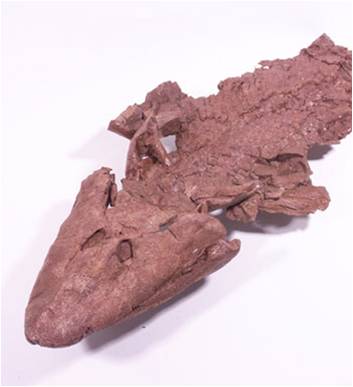
none
The material in chapter 23 will be covered more on thursday; tuesday's lecture is more transitional.
A Blurb on Radioactive Decay and Corroborations:
Radioactive dating-based on constant rate of ‘decay’ from one isotope to another
a. Principle:
- measure amt of parent and daughter isotopes = total initial parental
- with the measureable1/2 life, determine time needed to decay this fraction
- K40-Ar40 suppose 1/2 of total is Ar40 = 1.3by
(Now, critics say "be real"! How can we measure something that is this slow?)
- Well, 40 grams of Potassium (K) contains:
6.0 x 1023 atoms (Avogadro's number, remember that little chemistry tid-bit?).
So, For 1/2 of them to change, that would be:
3.0 x 1023 atoms in 1.3 billion years (1.3 x 109)
So, divide 3.0 x 1023 by 1.3 x 109 = 2.3 X 1014 atoms/year.
Then, divide 2.3 x 1014 by 365 (3.65 x 102) days per year = 0.62 x 1012 per day ( shift decimal = 6.2 x 1011)
Then, divide 6.2 x 1011 by 24*60*60 = 86,400 seconds/day: (= 8.64 x 104) = 0.7 x 107 atoms/second
0.7 x 107 = 7 x 106 = 7 million atoms changing from Potassium to Argon every second!!!
This radiation is detectible and measureable...
It is actually a very easily measured rate. And you can come back and measure it again tomorrow, next week, next year, or in 50 years...always the same... There are LOTS of atoms, so even if the percent changing is very small, or the rate is very slow, there is still a sizeable, constant stream of atoms decaying at any one time.
And they put out enough energy to warm things up considerably... which is what happens in a nulear reactor... water is heated by radioactive decay until it boils to steam, and this steam, under pressure, is used to turn a steam turbine and produce electricity. Now, to get all this to work right, you need to use the right amount of enriched uranium and the right amount of water. And of course, we need to know the rate of decay, because that's the process producing the heat energy. We know it. We rely on it being constant. We are so confident in that knowledge that we exploit this potentially dangerous process to generate electricity. This constant decay rate that occurs in a reactor is the same process that occurs naturally in rocks, and allows us to date the age of rocks.
b. C14 - decays to C12 with a half-life of 5730 years
c. Longer periods - use different elements with longer half-lives
- K40 decays to Ar40 at a rate of 50%/1.3 b years
- U238 - Pb208 = 4.5 by
- Rb87 - St87 = 47 by
- U238 - Thorium 230 = 80,000
- U235 - Protactinium231 = 34,000
d. Fission tracking
- U238 is found in zircon crystals. When it decays, the nuclear particles shoot of through the crystal and disturb the lattice - leaving a track. Count up the tracks with an electron microscope.
e. Results and Corroborations
- oldest rocks on earth = 3.8 by (solidification of earth's crust)
- moon rocks, meteorites = 4.5 by (origins of solar system)
4.. corroborations:
- our ability to understand many atomic properties in physics (nuclear power)
is dependent on constant decay rates. If they weren't constant, our predictions
wouldn't fit the observations
-C14, U235 tests - can be tested against known historical events (Wood in Tombs, Pompeii)
- multiple, independent tests on same sample - give same date
- astronomers have postulated that, because of tidal friction and the mass of the oceans and the earth, the duration of an earth’s rotation (day) has slowed at a rate of 2 seconds every 100,000 years. (So days were SHORTER in the past and have SLOWED to current 24 period) This means a year in the past would have MORE days than it does now. Corals lay down a layer of calcium carbonate 'exoskeleton' every day. There are seasonal changes in the thickness of the layers, so years can be distinguished, too. Astrophysicists predict that, based on tidal friction, a year 380 million years ago would have contained 400 days.
So, if corals are dated by radioactive means at 380 million years, then they should have 400 layers (days)/year. Prediction - test - data: They do. So, we can use basic physics to predict the "age" of a coral. And when we compare that "age" to the "age" determined by radioactive decay, the ages are the same. So, either they are both true, or they are both wrong in the same way. It is unlikely that we have such basic physics wrong. Very unlikely. So, the Earth is, indeed, very very old. Radioactive decay is constant; if it wasn't, or if it hadn't been in the past, none of these comparisons would work. period. But they DO work, and so it is irrational to conclude that the Earth is young, or that radioactive dating doesn't work or is somehow "dubious". Again, our ability to harness the power of decay in reactors is powerful testimony to the degree of confidence we have in our knowledge and understanding of the decay process. And thus, we have great confidence in the great age of the Earth.
Check out this Video on Ardipithecus ramidus: